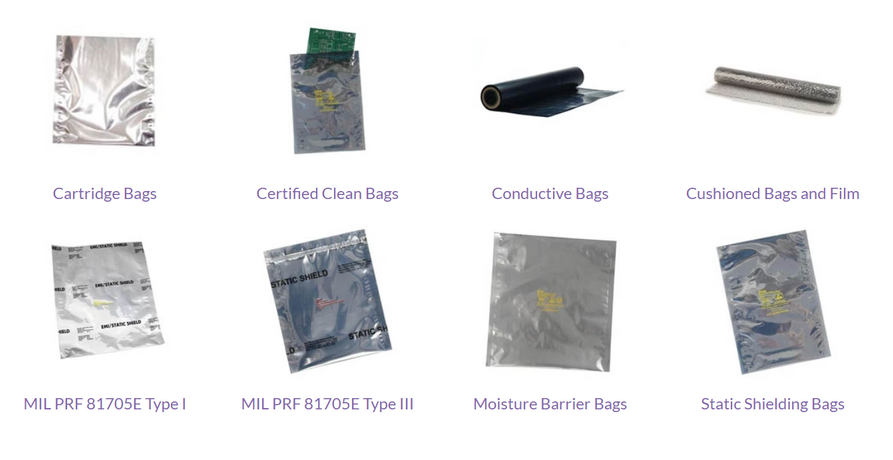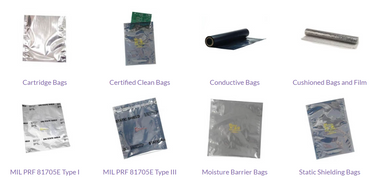- No products in the cart.
Electrostatic discharge (ESD) poses a significant threat to sensitive electronic components, leading to potential damage or failure. To combat this, ESD bags play a crucial role in protecting electronics during storage, transportation, and handling. In this comprehensive guide, we will explore the purpose, construction, and importance of ESD bags, as well as the various types available in the market. Understanding ESD bags and their proper usage is essential for safeguarding electronic devices and ensuring the reliability of sensitive components.
What are ESD Bags?
ESD bags are bags that are made from materials that are designed to dissipate static electricity. This prevents static electricity from building up and causing a discharge, which could damage electronic components. ESD bags come in a variety of sizes and types, so there is one that is right for every application.
How do ESD Bags Work?
ESD bags work by dissipating static electricity through a process called tribocharging. Tribocharging is the process of charging a material by rubbing it against another material. When two materials are rubbed together, electrons are transferred from one material to the other, creating a difference in electrical potential.
The materials that are used to make ESD bags are designed to dissipate static electricity quickly and efficiently. This prevents the static electricity from building up and causing a discharge.
Types of ESD Bags
There are two main types of ESD bags: antistatic bags and static shielding bags:
-
Antistatic bags are made from materials that are designed to dissipate static electricity. They do this by adding static dissipative additives to the material. These additives make the material more conductive, which allows it to dissipate static electricity more easily.

-
Static shielding bags are made from materials that are designed to shield electronic components from ESD. They do this by creating a Faraday cage around the components. A Faraday cage is a metal enclosure that blocks electromagnetic fields. When an ESD discharge occurs, it is blocked by the Faraday cage and cannot reach the electronic components inside.
Construction and Static Dissipative Properties
ESD bags are typically constructed from multiple layers of materials with specific properties that provide protection against electrostatic discharge. The outer layer of the bag is usually composed of a static-dissipative material that prevents charges from building up on its surface. The middle layer acts as a barrier to restrict the penetration of external static charges. The inner layer, known as the low-charging layer, prevents the generation of electrostatic charges when objects come into contact with it.
ESD bags can be either metallized or carbon-filled. Metallized bags have a thin layer of metal coating that provides shielding effectiveness by reflecting external electrostatic fields. Carbon-filled bags, on the other hand, contain conductive carbon particles dispersed throughout the bag material, offering low-resistance paths for charge dissipation. Both types of bags are effective in controlling ESD.
Testing and Certification
To ensure the quality and performance of ESD bags, rigorous testing and certification processes are conducted. These tests measure various properties, including surface resistivity, discharge shielding, charge generation, and charge decay time. The most common standards used for testing and certification are ANSI/ESD S20.20 and ANSI/ESD STM11.31.
When selecting ESD bags, it is crucial to look for certification labels or symbols indicating compliance with these industry standards. These certifications verify that the bags meet the necessary criteria for ESD protection and have undergone thorough testing procedures.
Proper Usage of ESD Bags
Proper Usage and Considerations (200 words): Proper usage of ESD bags is essential to maximize their effectiveness in protecting electronic components. Here are some key considerations:- Handling and Sealing: ESD bags should be handled in an ESD-protected environment and sealed correctly to maintain their protective properties. Ensure that the bags are closed securely using methods such as heat-sealing or zipper closures.
- Compatibility: ESD bags should be compatible with other ESD control measures in your facility, such as grounded work surfaces, wrist straps, and conductive shelving. All elements of your ESD protection system should work harmoniously to provide a comprehensive solution.
- Environmental Factors: ESD bags are sensitive to moisture and humidity. It is important to store them in a controlled environment with low humidity levels to prevent the accumulation of moisture inside the bags, which can compromise their effectiveness.
-
Labeling: Properly label ESD bags with essential information, including part numbers, lot numbers, and ESD sensitivity indicators. This helps with easy identification and traceability of components stored inside the bags.
Conclusion
In summary, understanding ESD bags and their purpose is crucial for maintaining a controlled environment that safeguards electronic components from electrostatic discharge. By implementing proper usage, selecting the right types of ESD bags, and following best practices, we can ensure optimal ESD protection and the longevity of sensitive electronic devices.
In addition to the information that we have covered in this blog post, there are many other resources available that can provide you with more information about ESD bags. The ESD Association is a great resource for information about ESD protection. You can find more information on their website at https://www.esda.org/: https://www.esda.org/.
So, the next time you handle or store electronic components, remember the importance of ESD bags and their role in preserving the integrity and reliability of these valuable devices. Invest in high-quality ESD bags, follow proper procedures, and make ESD protection an integral part of your electronic manufacturing processes.
For over 40 years, Lab Pro Inc. has been committed to delivering the highest quality ESD Bags, lab supplies, lab equipment, reagents, Excelta tweezers and cutters distance learning kits, and cleanroom PPE apparel. Renowned by global medical device companies and laboratories, we ensure exceptional quality in every product. Contact us online or call 888-452-2776 to learn more. Discover top-notch lab supplies and elevate your experiments today!












































